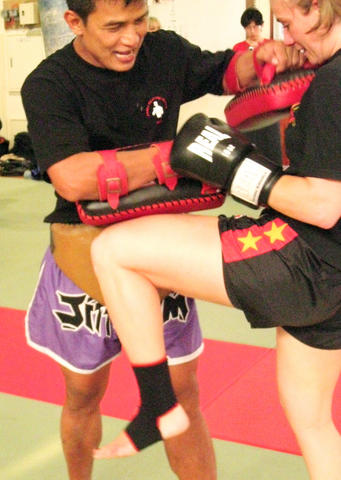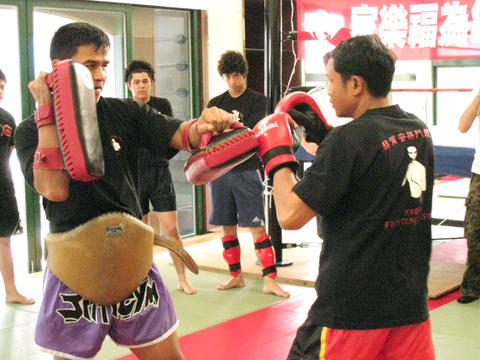"Right, left, right, elbow ... right, left, right elbow," calls out Serm Damriram in quiet, understated tones. His voice is so soft that it can hardly be heard above the thwack of glove against pad as Chrisanne Roseleip unleashes everything she's got. Damriram nonchalantly kicks up a leg and pushes her away, before telling her to launch the next attack with her feet, kicking up at a pad held at head height. Roseleip's foot and shin smash into the pads with a resounding smack, once, twice ... eight times. Damriram smiles with approval as Roseleip catches her breath. Being attacked by elbows, knees, fists and flying feet is all in a day's work for the former Muay Thai champion who was in Taipei at the weekend to help conduct a seminar in Thai boxing for around 30 Muay Thai and kickboxing enthusiasts.
The seminar was hosted by Antoine Fares and his Fares Academy, which specializes in mixed martial arts (MMA), with the stated intention of publicizing Thai boxing and opening channels with the local martial arts community. The event was held at a dojo in Neihu under the auspices of the Taiwan Jujitsu Federation (台灣柔術協會). There was an enthusiastic turnout of mostly foreigners, eager for the chance to spar with professionals.
Arnaud Perron, a high school student in Taipei with a long-standing interest in martial arts, has been practicing Muay Thai for a year, and was enthusiastic about its benefits. "Since I started practicing Muay Thai, pretty much a whole lot of things have changed in the way I live. It is a sport in which you can't come [to practice] feeling dizzy, you have to be really healthy to actually be able to keep up [with the training]. This made me keep up a healthy life."

Photo: IAN BARTHOLOMEW, TAIPEI TIMES
Students practiced with each other, while Damriram and Krittaya "Berm" Makate, the two Thai professional boxers invited to teach at the seminar, took individuals aside to refine their technique. "They told me some little details of things I was doing wrong, ... like throwing a hand to the side when I am doing a front kick ... small details that are really important, like in a competition," Perron said.
Watching from the side as Perron and others gave it all they had, smashing foot and fist into the pads, Tsao Yung-ching (曹永慶), a coach with the Taiwan Jujitsu Federation commented on the lack of local participation. "Foreigners really go for it," he said. "They're too fiercely competitive."
"It's great for the young people," Tsao added, "but for older people like myself, we want something different. ... There is a martial art for each stage of life. This is for the young. It's all about fighting and winning. But martial arts are not just about winning a fight."

Photo: IAN BARTHOLOMEW, TAIPEI TIMES
For Roseleip, who has already gone professional in the US circuit, it's exactly what Muay Thai is all about. "I think it's a beautiful sport ... the thrill of the victory, and the anticipation of your opponent, the nerves. All of that stuff ... it's like an addiction. It's also the best workout I've ever had, and I've done many different sports," said Roseleip, who teaches math at the Taipei American School and hopes to travel to Thailand next year to prepare for professional fights there.
Coach Tsao looked on philosophically as the students grunted and perspired through their routines. "A sport like this has a low entry barrier," he said. "If you train for three months, you have three months of skill. Chinese martial arts are much more abstract. It can take years to achieve a real standard. Young people don't want that."
Event notes:
The Fares Academy is planning seminars with masters in various styles of martial arts. On April 26 and April 27, Adam Kayoom, an expert in Gracie Brazilian Jujitsu, will hold a workshop with the Fares Academy. More information can be found at the academy's Web site www.antoinefares.com

May 26 to June 1 When the Qing Dynasty first took control over many parts of Taiwan in 1684, it roughly continued the Kingdom of Tungning’s administrative borders (see below), setting up one prefecture and three counties. The actual area of control covered today’s Chiayi, Tainan and Kaohsiung. The administrative center was in Taiwan Prefecture, in today’s Tainan. But as Han settlement expanded and due to rebellions and other international incidents, the administrative units became more complex. By the time Taiwan became a province of the Qing in 1887, there were three prefectures, eleven counties, three subprefectures and one directly-administered prefecture, with

Taiwan Power Co (Taipower, 台電) and the New Taipei City Government in May last year agreed to allow the activation of a spent fuel storage facility for the Jinshan Nuclear Power Plant in Shihmen District (石門). The deal ended eleven years of legal wrangling. According to the Taipower announcement, the city government engaged in repeated delays, failing to approve water and soil conservation plans. Taipower said at the time that plans for another dry storage facility for the Guosheng Nuclear Power Plant in New Taipei City’s Wanli District (萬里) remained stuck in legal limbo. Later that year an agreement was reached

What does the Taiwan People’s Party (TPP) in the Huang Kuo-chang (黃國昌) era stand for? What sets it apart from their allies, the Chinese Nationalist Party (KMT)? With some shifts in tone and emphasis, the KMT’s stances have not changed significantly since the late 2000s and the era of former president Ma Ying-jeou (馬英九). The Democratic Progressive Party’s (DPP) current platform formed in the mid-2010s under the guidance of Tsai Ing-wen (蔡英文), and current President William Lai (賴清德) campaigned on continuity. Though their ideological stances may be a bit stale, they have the advantage of being broadly understood by the voters.

In a high-rise office building in Taipei’s government district, the primary agency for maintaining links to Thailand’s 108 Yunnan villages — which are home to a population of around 200,000 descendants of the Chinese Nationalist Party (KMT) armies stranded in Thailand following the Chinese Civil War — is the Overseas Community Affairs Council (OCAC). Established in China in 1926, the OCAC was born of a mandate to support Chinese education, culture and economic development in far flung Chinese diaspora communities, which, especially in southeast Asia, had underwritten the military insurgencies against the Qing Dynasty that led to the founding of